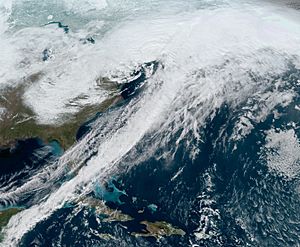Storm Ciara facts for kids

Satellite imagery of Ciara off the East Coast of the United States on 7 February
|
|
| Type | Extratropical cyclone European windstorm |
|---|---|
| Formed | 3 February 2020 |
| Dissipated | 16 February 2020 |
| Lowest pressure | 943 mb (27.85 inHg) |
| Highest gust | 136 mph (219 km/h) at Cap Corse, Corsica, France |
| Maximum snowfall or ice accretion | Snow – 23.5 in (60 cm) at Warren, Vermont |
| Damage | At least £1.6 billion (€1.9 billion) |
| Power outages | >1,185,000 |
| Total fatalities | 17 fatalities |
| Areas affected | Southern United States, Northeastern United States, United Kingdom, Ireland, Isle of Man, Northern Europe, Western Europe, Eastern Europe, Central Europe, Spain, Faroe Islands |
Storm Ciara was a powerful and long-lived extratropical cyclone that was the first of a pair of European windstorms to affect the United Kingdom and Ireland at peak intensity less than a week apart in early February 2020, followed by Storm Dennis a week later. Ciara caused widespread wind and flooding damage across Europe, and at least 13 fatalities.
The system emerged into the North Atlantic and underwent explosive cyclogenesis; the first severe weather warnings were issued for the United Kingdom and Ireland on 4 February well in advance of the storm's arrival. It was officially named Ciara by the Met Office the following day, becoming the twelfth named storm of the 2019–20 European windstorm season. Ciara subsequently made landfall in northern Scotland on 9 February and Norway the next day.
The precursor low named Winter Storm Kade by The Weather Channel brought heavy snowfall to the northern United States and eastern Canada, especially Newfoundland, New England and New York; further south in the Mid-Atlantic and Southeastern U.S., flooding and tornadoes were reported.
The worst effects from Ciara were felt in Ireland and the United Kingdom, where the storm arrived over the weekend of 8–9 February, bringing high winds and heavy rainfall that caused severe damage, widespread flooding, and three fatalities in the latter country. As Ciara moved across northern Europe with an unusually large wind field, eight further fatalities were recorded in a wide range of countries in mainland Europe, including as far away as Slovenia.
Highest wind gust per country
| Country | Max. Gust | Location |
|---|---|---|
| 176 km/h | Capel Curig | |
| 154 km/h | Sligo | |
| 173 km/h | Brocken | |
| 149 km/h | Hinterer Brunnenkogel | |
| 219 km/h | Cap Corse | |
| 130 km/h | Vlieland | |
| 146 km/h | Władysławowo | |
| 164 km/h | Lignano Sabbiadoro | |
| 175 km/h | Henningsvær | |
| 136 km/h | Smögen | |
| 134 km/h | Thyborøn | |
| 155 km/h | Säntis | |
| 130 km/h | Ostend |

